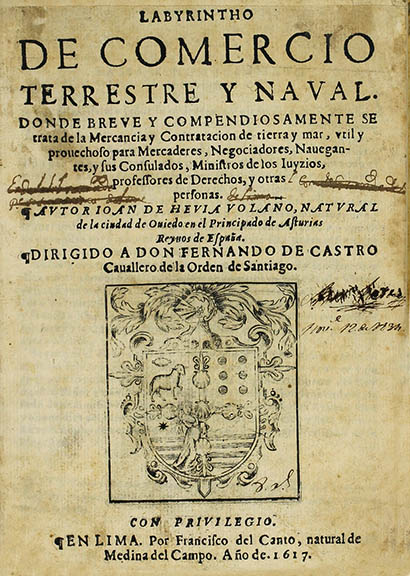
Libraries
Libraries
Labyrintho de comercio terrestre y naval donde breve y compendiosamente trata de la mercancía y contratación de tierra y mar
Juan de Hevia Bolaños (Oviedo, Spain, 1570 – Lima, Peru, 1623), a learned man who had arrived in Peru in 1601, published in Lima in 1603 the famous treatise Curia Philipica. The Labyrintho de comercio terrestre y naval was treated as the second part of said first work and, since the middle of the seventeenth century, both texts have been edited together. We must wait until the seventeenth century for the Labyrintho to be translated into Latin in Italy.
The work of Hevia, following the model of economic and commercial treaties such as that of Tomás de Mercado (Tratados y contratos de mercaderes y tratantes, Salamanca, 1569), composed or compiled treaties that were endorsed, -as is the case of the present- by distinguished jurists such as Juan Solórzano Pereira. This, author of the famous Indian Politics, pointed out in his censorship that the only objection he presented to the Hevia print was that its text, far from being a confusing labyrinth, was a compendious volume that clearly presented information on the intricate and vast transoceanic commercial.
Labyrinth was, as stated in Authorities, “cierto género de versos o dicciones, ordenadas y regladas con tal disposición, que se puedan leer de muchos modos, y por qualquiera parte que se eche, se halla passo para la copla, siempre con consonancia, sentencia y sentido perfecto “. Thus understand the arrangement with which its author has arranged the various news about merchants, banks, loans, fairs and markets, weights and measures, shops, freight, sailors, prohibitions.

